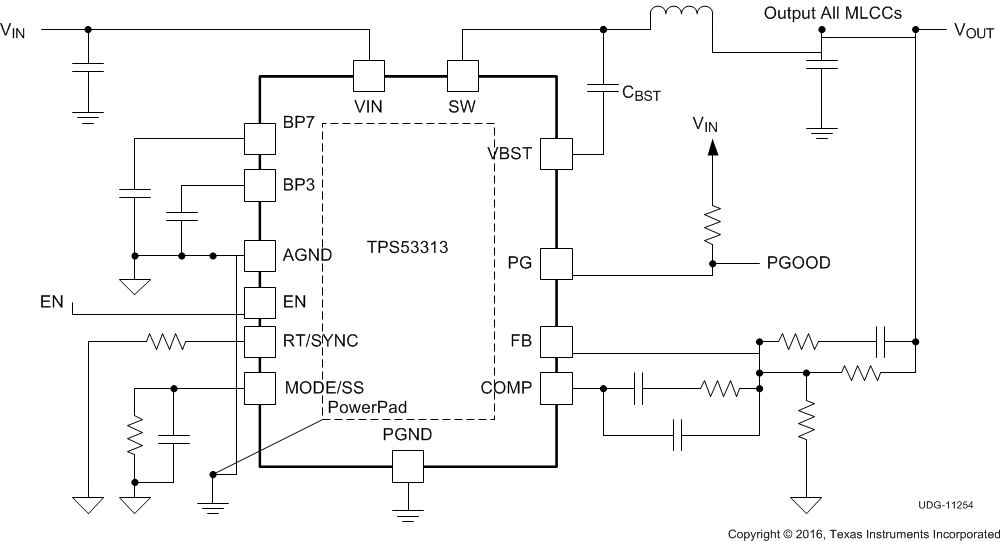ZHCSFM8A December 2011 – October 2016 TPS53313
PRODUCTION DATA.
- 1 特性
- 2 应用
- 3 说明
- 4 修订历史记录
- 5 Pin Configuration and Functions
- 6 Specifications
- 7 Detailed Description
- 8 Application and Implementation
- 9 Power Supply Recommendations
- 10Layout
- 11器件和文档支持
- 12机械、封装和可订购信息
1 特性
- 4.5V 至 16V 转换电压范围
- 可调节输出电压范围:0.6V 至 0.7 × VIN
- 6A 持续输出电流
- 支持所有多层陶瓷电容 (MLCC) 输出电容
- 可选跳跃模式或强制连续导通模式 (CCM)
- 可选软启动时间(1ms、3ms 或 6ms)
- 可选 4A-5A、6A 或 9A 峰值电流限值
- 优化了轻负载与重负载条件下的效率
- 电压模式控制
- 可编程开关频率范围:250kHz 至 1.5MHz
- 同步至外部时钟
- 针对过零检测和过流保护提供 RDS(on) 感测
- 软停止输出在禁用期间放电
- 在断续模式下提供过流、过压和欠压保护
- 过热保护
- 开漏电源正常指示
- 内部自举开关
- 4mm × 4mm 24 引脚超薄四方扁平无引线 (VQFN) 封装
2 应用
- 电压为 5V 的 负载点 (POL) 应用
- 12V 降压电压轨
3 说明
TPS53313 提供集成两个 N 沟道金属氧化物半导体场效应晶体管 (MOSFET) 的 5V 或 12V 同步降压转换器。由于低RDS(接通)和TI私有的 SmoothPWM™跳跃模式操作可优化轻载条件下的效率,同时不影响输出电压纹波。
TPS53313 具有 可编程开关频率(250kHz 至 1.5MHz),可选择跳跃模式或强制 CCM 模式操作。该器件提供预偏置启动、软停止、集成自举开关、电源正常功能和 EN/输入电压锁定 (UVLO) 保护。该器件支持 4.5V 至 16V 范围内的输入电压,无需额外使用偏置电压。可调节输出电压范围:0.6V 至 0.7 × VIN。
TPS53313 采用 4mm × 4mm 24 VQFN 封装(绿色环保,符合 RoHS 标准并且无铅),额定运行温度范围为 -40°C 至 85°C。
器件信息(1)
| 器件型号 | 封装 | 封装尺寸(标称值) |
|---|---|---|
| TPS53313 | VQFN (24) | 4.00mm x 4.00mm |
- 要了解所有可用封装,请见数据表末尾的可订购产品附录。
典型应用电路
